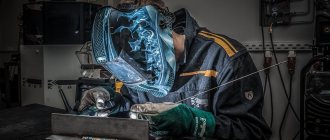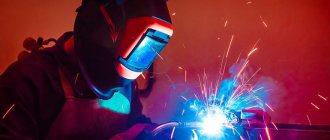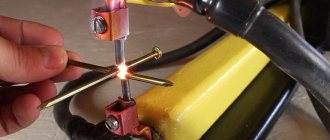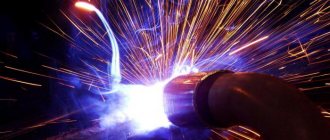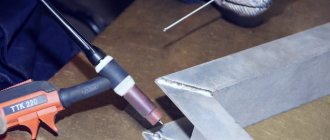Argon arc welding of bronze
Argon arc welding of bronze is carried out in the event of detection of casting defects or the formation of defects during surfacing and in other cases. Bronze parts are welded with preheating to approximately 350 - 400 degrees Celsius. Large products are heated to 500 - 600 degrees. The strength of bronze at high temperatures decreases significantly , so the part must be well secured before welding so that it is not accidentally damaged during the welding process.
After welding, bronze parts are annealed and heated to 700 degrees. The parts are kept at this temperature for 3 to 5 hours. Heating of castings begins at a temperature of 200 degrees, and the temperature rises by approximately 100 degrees per hour. For castings that perform critical tasks, temperatures up to 750 degrees Celsius are used. Rolled bronze is cold forged. This is done to increase the density and strength of the weld metal.
When welding with carbon electrodes, direct current of straight polarity is used. To weld tin bronze, rods are used that contain 8% zinc, 3% tin, 0.2 phosphorus, 0.3% nickel, 0.3% iron, 0.2% lead. The remaining material is copper. For other types of bronzes, rods of the same composition that make up the main metal being welded are used.
Bronze welding is widely used . The best welding results are obtained by welding with direct current of reverse polarity. The welding current is 30 - 40 Amperes per 1 millimeter of welding electrode diameter. If alternating current is used when welding, then in order to increase the stability of the arc, it is necessary to increase the current strength to 75 - 80 Amperes per 1 millimeter of electrode diameter. Also in such a situation, you can use an oscillator.
Welding of bronze is carried out without interruption in one layer . When welding, the electrode must be almost perpendicular to the surface of the metal. In order to better remove gases from the surface of the weld, zigzag movements are made. In order to obtain the maximum soldering height, it is necessary to conduct an arc with preliminary shaping of the welding site at an inclination of up to 15 degrees to the horizontal position. If welding is carried out without heating, then a larger welding current is used for this work.
If the bronze was welded in accordance with the requirements, then the mechanical properties of the weld are approximately the same as the properties of the base metal. For rolled bronzes, argon welding is used using non-consumable electrodes, such as tungsten.
Bronze is often welded using gas welding. In this case, welding is carried out with the part heated to 450 degrees Celsius. The welding flame must be reducing, because if it has oxidizing properties, the content of tin, aluminum and silicon will be greatly reduced.
Titanium welding technology
Titanium alloys are relatively new structural materials. Due to their valuable properties, they are widely used in chemical engineering, shipbuilding, rocketry, the aviation industry and other industries. The main advantage of such alloys is the unique combination of corrosion resistance with low density (4.5 g/cm3) and high mechanical characteristics.
The unique properties of titanium include: high strength, high resistance to corrosion in various aggressive environments, high melting point (+1665 °C), low density.
The low thermal conductivity and high electrical resistance of this material make it possible to spend much less electricity on its welding than on welding other types of non-ferrous metals. In addition, titanium is low-magnetic. This means that when working with it, the influence of magnetic blast is reduced.
The main difficulty when working with titanium and its alloys is the increased chemical reactivity of the material to hydrogen, nitrogen and oxygen at high temperatures. To obtain high-quality connections, it is necessary to provide good protection from interaction with the atmosphere of both the weld pool and the entire area of non-ferrous metal heated to more than +500 °C.
The edges must be prepared for welding by etching with a special solution containing 600 cm3 of water, 350 cm3 of hydrochloric acid and 50 cm3 of hydrofluoric acid. You can also process them mechanically until they have a metallic shine, and then degrease them.
Welding is always performed using submerged arc, manual and mechanized methods, in shielding gases, with titanium wire and a non-consumable electrode.
Manual argon arc welding of non-ferrous metal with a tungsten electrode should be carried out with direct current of straight polarity. With a part thickness of 0.5–4 mm, the welding current should reach 40–170 A, the arc should be 1–2 mm, and the tungsten electrode extension should be 6–8 mm. In this case, the argon consumption will be approximately 20–25 l/min. For automatic welding in argon, titanium wire with a diameter of 1.5–3 mm is used.
When performing submerged arc welding, the back of the weld should be protected with well-fitted copper or steel backing plates. The use of remaining titanium pads is also permitted.
Oxygen-free fluoride-chloride fluxes of the AN-T brand for various purposes are suitable for working with titanium. In this case, the height of the flux layer should not be less than the electrode extension, and the electrode wire extension should not exceed 20–25 mm. After cooling the non-ferrous metal below +400 °C, the slag crust is removed.
How bronze welding is performed, what techniques exist
Bronze has become very popular among materials. But the difficulties that arise during welding work significantly spoil the whole picture. Many people understand that bronze is not a chemical element, but an alloy, but not everyone knows that the composition of the material can be different.
In a general sense, bronzes mean copper alloys to which alloying elements such as aluminum, tin, silicon or manganese have been added.
Let us immediately note that in a number of physical properties bronze is similar to brass. In particular, identical welding methods are defined for these materials. In metallurgy, there is a clear division of alloys. If copper and zinc are used as the main element, the resulting alloy is called brass.
Types of bronze are determined depending on which element is used for alloying. In the simplest classification, bronze can be divided into tin and tin-free. Tin bronze in its composition, in addition to copper and tin, can contain nickel, phosphorus, and zinc. It is believed that it is the addition of tin to the alloy that makes it of higher quality.
Welding brass with argon - solving difficulties together
Sometimes you have to deal with tasks such as welding brass with argon on one scale or another. Brass itself, like most other non-ferrous metals, is quite difficult to weld. Therefore, if you are not involved in this, or if this is the first time you need to weld a damaged part, or complete a specific order, you will have to first familiarize yourself with the problems and features of the welding technique for this metal.
Issues
Brass is a metal that is a binary or multicomponent alloy based on copper, in which the main alloying component is zinc; lead, tin, manganese, nickel, and iron can be partially added. Due to its properties, brass is difficult to weld, as it changes its physical properties when rapidly heated and subsequently cooled. For example, the strength of a welded joint is strongly influenced by such factors as - the presence of zinc; — presence of hydrogen in the oxide film.
In the first case, Zn evaporates under the influence of high temperatures (it is known that zinc evaporates already at 420 degrees, and boils at 907 degrees, which coincides with the melting point of brass), due to which dangerous vapors are released, and brass acquires poor ductility . In the second, due to hydrogen, the welding seam is saturated with bubbles and, as a consequence, its weak strength.
blog.svarcom.net
Peculiarities
Often, when cooking tin bronze, a phenomenon such as the formation of frozen drops is observed. This happens for the reason that fusible fractions float to the surface. Components such as lead and zinc are subject to waste. Their boiling point is lower than that of copper, so natural evaporation occurs.
The type of flame should be controlled. It must be strictly normal. An oxidizing flame burns out the tin, and a carburizing flame causes pores to appear. Acetylene consumption during gas welding should be 70-120 liters per hour per 1 mm of metal sheet thickness. The surface must be in the reduction flame zone, which is 7-10 mm. This is the only way to reduce the degree of tin burnout.
It is recommended to preheat cast bronze parts to a temperature of 450°C degrees. The filler material is BrOTs4-3 or BrOF6.5-0.15 wire. Difficulties in welding aluminum bronze are associated with the formation of an oxide film, which has a high melting point. It can only be dealt with with a special flux. The latter is a substance containing sodium fluoride, sodium chloride, barium chloride and potassium chloride. Silicon bronze, unlike other types of alloys, is weldable well due to the presence of elements such as silicon and manganese.
There are features characteristic of any alloy containing copper. The welder must be aware of these features, because he will certainly encounter certain difficulties. The presence of copper in an alloy determines its physical properties. The thermal conductivity of bronze, like brass, is quite high, as a result of which intensive heat transfer must be taken into account. Rapid crystallization is accompanied by the formation of cracks. Another factor influences here - a high coefficient of thermal expansion. When a metal crystallizes, it “contracts”, resulting in internal stresses.
Bronze is widely used by artists and sculptors in the manufacture of busts or monuments. It is used to make fittings and decorative elements. Welding work must provide not only a reliable connection, but also an aesthetic appearance. The presence of elements such as zinc, tin or lead in alloys largely determines the characteristics of welding work.
The burnout of the listed elements is due to a significant difference in boiling points. After the metal melts in the weld pool, atmospheric oxygen is absorbed. Alloying elements react with it. A film forms on the surface of the bath. At the same time, hydrogen enters the metal, and during crystallization, pores remain. They significantly reduce the quality of the weld.
Some problems can be solved by protecting the bath with inert gas. Argon is most often used. All of the above indicates that bronze welding is a rather complex process, so the welder must have certain knowledge and experience.
Copper welding, features
Fluxes applied to filler rods and weld grooves are used to improve the welding process and protect the metal from oxidation. Based on their composition, fluxes are divided as follows:
- 68% calcined borax, 15% sodium phosphate and silicic acid each, 2% charcoal.
- 0% calcined borax, 15% sodium phosphate and silicic acid each, 20% charcoal.
- Calcined borax, to which 4-6% metallic magnesium is added.
With a sheet thickness of no more than 4 mm, welding can be performed without filler metal. If the thickness exceeds 4 mm, the edges must be beveled at an angle of 35-45°. To prevent leakage of liquid hot weld metal, it is necessary to ensure a minimum assembly gap for welding, which can reach 0.5 mm. The ends of the seam need to be molded. Welding of copper should be carried out exclusively in the lower position, the angles of inclination of the gas torch should be minimal.
When welding copper, ceramic, asbestos or graphite backings should be used.
How to prepare flux?
The basis of the flux is borax, which increases the gas penetration of the weld. To calcinate borax, you need to do several manipulations:
- Fill a porcelain or chamotte crucible up to 1/3 with borax and place it in an oven heated to 400-500°C. The borax will be calcined only after it bulges and settles to the bottom of the crucible.
- From the resulting mass you need to make a powder and transfer it to an airtight container.
Copper Welding Process
After assembling the joint for welding, it is necessary to clean the edges from rust, scale and various contaminants, while the width should be equal to 30 mm from the center of the groove. Copper filler wire should contain up to 0.2% phosphorus mass. The diameter of the wire depends on the thickness of the sheet of metal being welded and can be in the range of 50-75%.
Then the calcined borax is prepared. The power source is set to mode 4 or 5, the voltage at the burner should be 160-180V. Copper welding is carried out uphill without interruption in one pass. The angle of inclination of the torch to the product should be 40-50°, the filler wire – 30-40°. The distance from the surface to be welded to the nozzle should not exceed 4-8 mm.
Flux is introduced directly into the welding site using a spoon or scoop. It is necessary to periodically add flux to the end of the filler wire or apply it in advance in the form of a paste. Flux residues are removed by washing with a 2% solution of sulfuric or nitric acid.
To improve the mechanical properties of the product, the weld metal should be forged when it has cooled. If the thickness of a metal sheet exceeds 4 mm, it should be forged in a heated state (temperature up to 500-600°C). If you want to obtain a product with a higher degree of viscosity of the weld metal and the area near it, the product must be heated to 500-600°C and immediately cooled in water.
Preparing for work
Today, welding of bronze, like other alloys containing copper, is carried out in three ways: manual arc welding, argon arc welding and gas welding. Preparatory work is defined for each type of work and does not depend on the choice of welding method. The need to prepare metal surfaces is dictated by the requirements for the weld.
First of all, by mechanical processing it is necessary to form edges that will adjoin each other with the maximum area. Then, using sandpaper or any abrasive tool, you will have to polish the ends until a characteristic golden shine appears. This procedure must be performed in any case, since bronze is quickly covered with a layer of oxide, which can prevent the formation of a high-quality seam.
If it is not possible to carry out mechanical treatment, and the edges are in normal condition, then you can get rid of the oxide using a solution of nitric or hydrochloric acid.
Brass - soldering with a soldering iron
Brass and copper, or brass and copper-containing materials, can be joined by low-temperature soldering using a 100-watt soldering iron.
The solder must be tin-lead alloy POS60 or higher. Phosphoric or soldering acid can serve as a flux.
Before working with brass, remove the oxide film and degrease the surface. Soldering should be done with the soldering iron well heated.
In addition, before soldering, it is necessary to pay careful attention to surface treatment with flux, which is carried out immediately before bringing a heated soldering iron with solder.
Using a soldering iron, you can join brass using silver solders (PSr40 and higher) . However, the power of the soldering iron should be from 0.5 to 1 kW, and the heating temperature should be from 500C. It is recommended to use a borax-based flux, or you can use concentrated phosphoric acid.
In this way, you can fill various defects formed in solid brass products (radiators).
Manual arc welding
Bronze welding is most often necessary when carrying out repair work, correcting defects or when surfacing. You can use preheating of the part to 350-450°C degrees, but it should be remembered that at high temperatures the strength of bronze decreases. Manual arc welding is carried out in the lower position. Metal or carbon electrodes are used as consumables.
- When using a metal electrode, a constant welding current of reverse polarity is set.
- Carbon electrodes require straight polarity.
Welding with alternating current is also possible, but for a stable arc the current strength must be significantly higher. If with direct current it is selected based on the calculation of 40 A per 1 mm (electrode diameter), then for alternating current the figure increases to 80 A. The seam is applied continuously, without transverse movements of the electrode.
Diffusion welding
Diffusion welding is the process of producing a permanent welded joint due to the diffusion (incorporation) of atoms of one metal (usually softer) into the crystal lattice of another (harder).
Thus, it is possible to obtain strong permanent connections of dissimilar metals (bimetal), as well as non-metals (for example, ceramics with glass). The method was invented in the 53rd N.F. Kazakov and is still widely used, in particular in the production of hydraulic motors for aircraft. It can also be used in other areas, especially where it is necessary to obtain precision friction pairs, and parts and assemblies are assembled using antifriction materials and operate at high speeds. An example of such a pair is the connection of tin-lead-nickel bronze BrOSN-10-2-3 with steel 30Х3ВА - it is used in the cylinder block of an aircraft plunger pump.
Argon-arc
This type of welding is fundamentally similar to manual arc welding. The only difference is that the process occurs in a protective gas environment. Argon is heavier than air, so it forms a protective zone through which atmospheric oxygen does not enter the weld pool. Argon arc welding can be carried out with non-consumable tungsten electrodes or consumable electrodes, the role of which is played by rods.
It is argon arc welding that is most often used when working with bronze and brass. This preference is especially given when the metal thickness exceeds 5 mm. Welding productivity is quite high, but the process itself requires the welder to have certain qualifications. An electric arc formed between the metal surface and the electrode partially melts the edges, after which a connection occurs to form a seam. As mentioned above, preliminary preparation of the edges is required.
There are a number of recommendations that allow you to obtain high-quality connections between parts made of copper alloys.
- It is advisable to form the seam in small sections.
- When the process is finalized, the voltage gradually decreases, and then the arc is moved to the side.
- To prevent evaporation of alloying elements, special additives containing silicon, aluminum or boron are used.
Welding bronze and brass is accompanied by the release of toxic substances, so it is carried out in compliance with all possible safety measures. Argon welding has a number of advantages over other types of joints.
- Obtaining an aesthetic seam.
- Economical process.
- There is no need to clean the part from slag.
- For bronze, argon welding is the most preferable.
- Argon welding can be used to fuse parts, restoring their previous shape (for example, when worn).
- It is possible to work with thin sheet metal.
Gas
Gas welding of copper alloys is used primarily in order to minimize the waste of alloying elements. The welding flame is adjusted so that three zones are clearly distinguished. The metal surface should be on the border of the second and third zones. Working with silicon bronze requires an oxidizing flame. It is obtained by burning a mixture of oxygen and acetylene, if the ratio of the first gas to the second is 1.2. Bronze containing aluminum causes many problems during welding, since a film of aluminum oxide is formed, thickening the contents of the weld pool.
In the absence of preliminary and subsequent heat treatment of the seam, the quality and strength of the joint obtained using gas welding is 85% of the strength of the base metal. A good result can only be obtained after forging the seam. Gas welding requires a lot of experience from the master. At low burner speeds, pores may form in the metal. It is necessary to correctly select the burner power, gas composition, based on the type of bronze and the thickness of the workpiece.
Features of welding work with copper alloys
Brass is often compared to bronze. After all, bronzes are also alloys in which copper is present, and the second main component can be aluminum, silicon, lead, beryllium, and so on.
The thermal conductivity of copper is 6 times greater than that of iron. And therefore, the technology for welding copper alloys has serious differences from the technology for welding steel and iron products
It is also important to note that things made of brass or bronze often have decorative value. This means that when welding you need to use the mode that will allow you to get a perfectly smooth seam and give durability to the connection.
All copper alloys have certain common features, but each of them also has its own unique properties. For example, the fact that it contains zinc is of particular importance when working with brass.
It is this element from the periodic table that makes welding brass so difficult. There are several difficulties that craftsmen encounter during this process:
- gases are absorbed by the molten metal (zinc oxidation occurs and hydrogen bubbles appear in the weld);
- Pores and cracks easily form on brass when overheated;
- Zinc begins to burn out of the alloy, since it has a lower boiling point than copper.
To combat all the difficulties during welding, the protective environment of argon is used. Other types of welding are also used, not forgetting about the preparation of the material and strict adherence to the process technology.
Soldering brass - some features
Most often, brass soldering is performed with a gas torch, and borax, tin or other similar materials are used as solder. At home, you can use a soldering iron or a special graphite electrode for this work.
In principle, soldering brass is similar to processing cast iron, copper, and steel. However, it has its own subtleties and features that must be taken into account.
When soldering brass, it is very important to choose a flux . During the joining process, the oxide film must be removed from the surface of the alloy being processed. An ordinary rosin-alcohol flux is not capable of doing this, so it is necessary to use more active components containing zinc chloride as a base.
Solder for soldering brass should be selected especially carefully . To work with an alloy that has a high copper content, copper-phosphorus and silver components are excellent. You can use brass itself, but you need to take into account that its melting point as a solder should be lower than that of the base alloy. Quite often, brass is joined using hard solder, for example, L - CuP 6. Such joints are very strong.
Preparation
Today, in practice, when working with bronze and brass, electric arc, gas flame and argon welding is used. But regardless of which technology was chosen, it is necessary to carefully prepare the metal surfaces that are supposed to be welded.
To do this, special welding edges should be cut along the edges of the workpieces, and the future seam area should be polished until shiny using sandpaper and a file.
Oxides often form on brass surfaces, which also need to be removed . This can be done using a solution of hydrochloric or nitric acid. Moreover, such cleaning should be carried out strictly before starting welding work.
Soldering brass using a gas torch and soldering iron
Soldering is one of the methods of joining two parts, in which only the connecting material is melted, and the surfaces of the elements themselves are completely preserved. Using this method, you can connect dissimilar materials, rather small elements, fragile microcircuits, connect or grow wires, attach hard alloy plates, and carry out anti-corrosion treatment.
Most often, alloying is done using brass, which is an alloy of zinc and copper. Therefore, before starting work with a soldering iron, you should study the features of using this material.
Electric arc
For standard electric arc welding, it is best to use electrodes made of brass wire (and the share of zinc in this wire should be 40%) with inclusions of aluminum, iron, lead, and manganese.
When the device is turned on, a constant electric current of direct polarity must pass through these electrodes. In this case, welding is carried out with a short arc from a position from below.
The arc must be maintained at a current of 250 amperes for electrodes 5 mm long. In this case, the speed of laying the seam can reach 30 cm per minute.
At the end of the main operation, the weld should be additionally forged and heated to a temperature in the range from 600 to 650 °C. This will give the connection greater strength.
Gas
Of course, you can also cook the surfaces of brass products with a gas apparatus. But in this case, work must be carried out at maximum speed. If the burner moves slowly, pores will form in the seam - this is again due to the characteristics of zinc melting. Ultimately, the operating speed should be approximately 25 cm per minute.
Welding with a gas machine must be performed without transverse vibrations, otherwise the brass product will begin to melt. Experts advise keeping the burner at right angles to the surface of the product. During the process, the filler wire must be positioned at an angle of approximately 30 degrees to the edges being welded.
In an argon environment
Argon welding of brass is the highest quality and most popular option today.
Moreover, this is true not only for brass, but also for other copper alloys. This method is the same arc welding, but in an inert argon gas environment. And here it is possible to use both consumable and non-consumable electrodes.
Tungsten is usually used as a material for non-consumable electrodes. And in most cases, bronze rods of the BrKMts-3-1 brand can become a good filler material.
However, if the brass alloy is very complex, then filler wire should be used from the same material as the metal product itself.
Welding bronze or brass with an argon apparatus is performed in one layer. And at the same time, you need to cook not with a whole seam, but in small separate sections (rollers).
Welding brass with argon: technology features and practical tips
Among all types of welding, brass welding is one of the most complex technological processes. This is explained by the fact that zinc, which is part of this copper alloy, begins to actively evaporate when heated, which leads to the formation of pores in the weld and, accordingly, to a significant deterioration in the quality and reliability of the joint being formed. Welding brass parts is also complicated by the fact that when it is performed, zinc vapors are released, which are very harmful to human health.
Argon welding of copper alloy
Welding technologies for brass products
As you know, brass is an alloy of copper and zinc. In some cases, when it is necessary to obtain a metal with special characteristics, other chemical elements can be added to it - tin, nickel, lead.
Zinc, which is contained in a significant amount in brass, begins to evaporate when heated strongly, which leads to porosity in the welded joint. In addition, by reacting with oxygen contained in the surrounding air, zinc vapor is converted into the oxide of this metal, which forms a white coating on the surface of the parts being connected. Possessing refractoriness and thereby complicating the welding process, this coating poses a great danger to human health, as it is very poisonous.
Mechanical properties and chemical composition of brass
Taking into account all the above factors, experts have developed several technologies that can effectively weld brass. These include:
- gas and electric arc welding;
- joining brass parts under a layer of flux;
- welding performed in a shielding gas environment, which is most often used argon.
Of all the listed technologies, it is brass argon welding that has become most widespread due to its high efficiency and the ability to obtain high-quality welded joints in any conditions.
Features of welding brass products in argon
Brass welding, which is carried out in an inert argon gas environment, is used mainly in cases where it is necessary to connect parts whose thickness exceeds 5 mm. The heat source when using this technology is an electric arc burning between the electrode and the surface of the parts being connected. The electrode is fixed in the conductive clamp of the torch, through the nozzle of which shielding gas is supplied to the welding zone. The weld itself is formed through the use of filler material, the composition of which must best match the composition of the products being joined.
Copper Phosphorus Rod for Brass Welding
Melting of the filler material supplied to the welding zone manually is also ensured by the electric arc burning between the electrode and the parts.
Before you start welding brass, you must thoroughly clean the surfaces of the parts to be joined from dirt and oxide film. An indicator of the quality of such cleaning is the metallic shine that should appear on the surface of brass products. The oxide film from brass workpieces is easily removed using nitric acid. After such treatment, it is necessary to rinse the surfaces with hot water.
When welding brass products, you can hear an unusual crackling noise: it is caused by the active release of zinc vapors. Zinc vapor, in addition, colors the welding arc in an unusual color, which is clearly visible even in the video of this process.
Approximate modes for welding brass with a tungsten electrode
The technology for welding brass products is also different in that the connection is made not with a continuous seam, but with separate beads, carefully filling the gap between the parts to its entire depth with molten filler material. It is necessary to comply with this requirement because when making a continuous seam there is a very high risk of burning through the parts being connected.
There is one more rule that must be followed when welding brass products. When filling the weld crater with filler material, you must gradually reduce the arc voltage and increase its length, and then simply move the electrode to the side. You can see how this is done practically in the training video.
It is possible to weld brass products at home, but you should take into account the high health hazard of zinc fumes. That is why it is best to perform this process, if you do not have a workspace with exhaust ventilation at home, in the open air. In any case, wherever parts made from this alloy are welded, the welder should use a respirator.
Advantages of argon arc welding of brass parts
It is no coincidence that argon arc welding of brass products, carried out with non-consumable electrodes, is so popular. The advantages of this technological process are as follows.
- To weld brass in an argon environment, neither specially coated electrodes, which are quite expensive, nor flux are required.
- This technology for connecting parts made of brass is one of the cleanest from an environmental point of view.
- Argon welding is characterized by high speed of execution.
- Welds obtained by argon welding are distinguished by high aesthetic characteristics.
- There is no slag crust on welds made using this technique, which must be cleaned.
- The edges of the connected brass parts are reliably protected from the formation of oxide and nitride crusts through the use of inert gas.
- A jet of argon supplied to the welding zone blows out all waste from the technological process.
- This welding method is universal: it can be used to connect both small and large brass products and restore them using the surfacing method.
met-all.org
At home
At home, the easiest way is to use an existing or borrowed blowtorch and tin solder.
And as a flux, that is, a material that separates the welding zone from atmospheric air, you can use cheap and accessible sodium borate. Sometimes special solders from copper and silver are prepared for soldering brass. If you are going to weld brass at home using the electric arc method, you need to think about protective equipment and strict precautions. Zinc vapor poses a truly serious danger to human health - it is poisonous.
Therefore, when welding brass, it is imperative to wear a protective mask, gloves and a respirator. For the same reason, it is better to perform this process outdoors or in rooms with sufficiently powerful hoods.
Less experienced craftsmen will benefit from additional advice. First, it is advisable to practice on an unnecessary piece of brass of suitable sizes. Only after getting good at it and setting the correct settings for the device can you get down to real work.
Those who want to quickly join two metal objects should know what cold welding is. Although this name is not entirely correct. Relatively speaking, hitting two metal plates with a sledgehammer, as a result of which you can get a single product (and this is exactly what they did in ancient times), can also be considered cold welding.
But these days, this is what they call the connection of two metal parts thanks to special compounds, as well as these compounds themselves. They can be purchased at almost any specialty store and allow you to connect, repair and seal brass and bronze products.
The method of application is extremely simple: you need to stir the cold welding composition until you get a homogeneous mass. Then you should apply this mixture to both surfaces that need to be connected and press them tightly against each other for a few seconds .
In fact, cold welding is the glue for metals, and sometimes such glue can actually solve related problems at home. On the other hand, there are situations when real welding is indispensable.
Brass soldering process
For maximum efficiency of work, it is necessary to prepare the following materials and tools:
- gas burner;
- copper;
- graphite crucible;
- silver;
- asbestos base;
- boric acid.
In some cases bronze may be needed.
Solder preparation
First of all, it is necessary to prepare tenol, which will contain two parts of silver and one part of copper. To do this, using a gas burner, copper and silver will need to be melted and the required amount of material weighed out. Next, the alloys are placed in a crucible and heated with the same gas burner.
